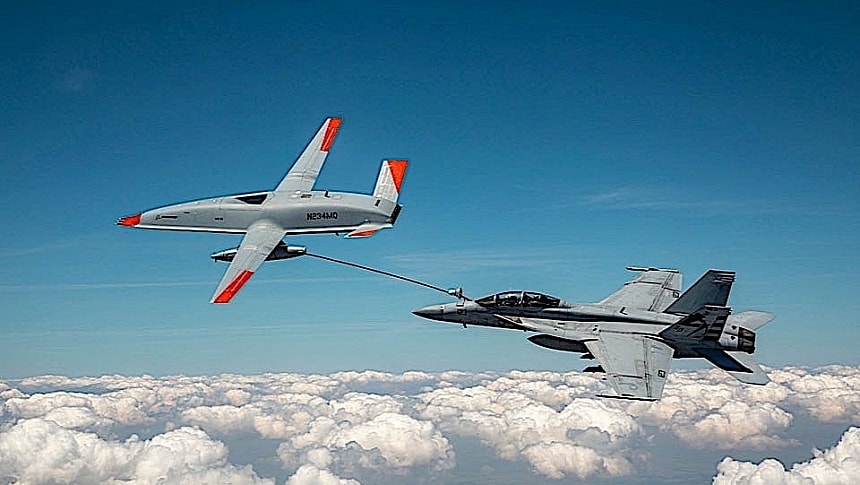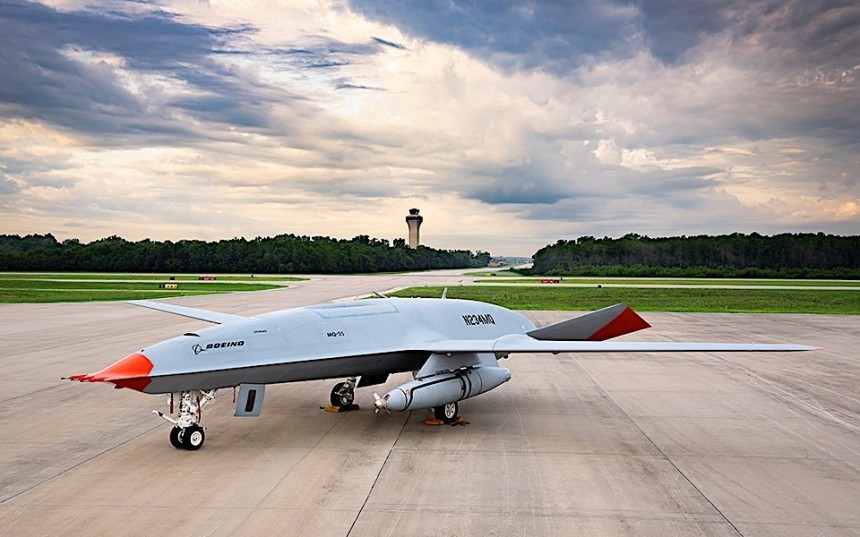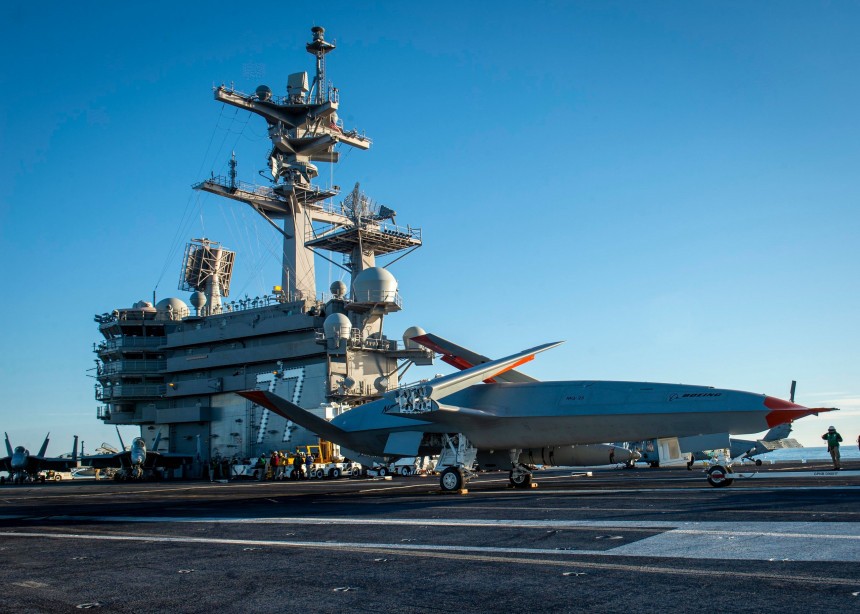It is obvious to anyone looking that drones of all shapes and sizes are rapidly taking over our world. From devices meant to shoot insane videos, these things have grown in a very short period of time into pieces of hardware able to do pretty much everything, from fighting wars to delivering goods. Exciting as they may be now, drones will really make an evolutionary leap once they learn how to cooperate with humans and the range of control options for them expands.
It's the military that is presently looking at pairing the capabilities of drones with the minds of humans in the air. Depending on who you ask, this pairing wears a number of names, but over at Boeing they call it manned-unmanned teaming (MUM-T).
What that term means is that in the near future drones and piloted aircraft will be able to fly alongside one another, with the machines helping the humans see their missions through, from reconnaissance to actual combat. Some, Boeing included, are even considering using drones as a sort of flying gas stations that can be placed in areas where crewed tankers are absent from for whatever reason.
The drone the company is currently trying to integrate for this purpose with its MUM-T tech is called MQ-25 Stingray. Made from the get-go by Boeing itself to be a refueling drone, the Stingray made its first flight back in 2019, and it has been continuously tested and upgraded ever since.
The aircraft is powered by a Rolls-Royce engine and can travel to distances as far out as 580 miles (930 km) from its departure point. Because it was designed first and foremost with U.S. Navy needs in mind, that departure point is more often than not an aircraft carrier.
The drone can carry 15,000 lbs (6,800 kg) of fuel inside a tank aptly called the aerial refueling store (ARS). It gets its directions from a control station on the aircraft carrier itself, heading to where it’s needed and performing the refueling task.
At least that’s what the Stingray was capable of until now, as Boeing announced it may add a new capability to the drone: it will allow control over its functions from pilots already in the air.
The new feature is made possible thanks to a software upgrade currently being tested in the virtual world using the Stingray drone and an F/A-18 Super Hornet. We’re told work is progressing at a rapid pace, and that means we might see such drone-aircraft pairings take place in the real world pretty soon.
Boeing simulated how a Super Hornet pilot could control the refueling drone and have it release its drogue so that the fighter jet could receive the precious fuel. All of this was done “using existing communications links on both platforms.”
The aerospace giant says the use of cockpit control over the Stingray should drastically cut the time it takes for the drone to receive instructions on what to do, but no numbers are provided to let us know exactly how drastically.
If successful, the tech might be deployed on the Navy’s Block II and III Super Hornets. Originally made by McDonnell Douglas back in 1995, these planes are presently the backbone of the Navy’s aerial punch.
Powered by a pair of General Electric turbofan engines capable of generating 22,000 pounds of thrust each, the Super Hornet can fly at speeds of Mach 1.8 (1,381 mph/2,222 kph) and can reach distances as great as 1,457 miles (2,346 km) when equipped for combat. When external tanks are used (three of them), the plane’s range increases to 1,899 miles (3,054 km).
Separately from its use as an aerial tanker for the Super Hornets, the company tested back in 2022 the Stingray drone’s ability to conduct intelligence, surveillance, and reconnaissance (ISR) missions.
The tests performed back then, also virtual in nature, involved aircraft taking to the drone directly, without going through the carrier-based control station. More specifically, a series of military aircraft (including an E-2D Advanced Hawkeye, a P-8A Poseidon and an F/A-18 Super Hornet) directly tasked the Stingray to conduct ISR.
Once it got its instructions, the drone was capable of validating the command, planning the route to its target area, and running the search pattern it was assigned.
If need be, the drone can carry weapons as well, thanks to it being fitted with underwing hardpoints. Although its main cargo remains fuel, the Stingray can carry a pair of anti-ship missiles.
The Stingray should be operational by the end of the decade, and Boeing plans to assemble them at a new facility in at MidAmerica St. Louis airport in Illinois. As per available info, Boeing could end up producing as many as 72 of these things, which may amount to a total value of $13 billion over the coming years.
What that term means is that in the near future drones and piloted aircraft will be able to fly alongside one another, with the machines helping the humans see their missions through, from reconnaissance to actual combat. Some, Boeing included, are even considering using drones as a sort of flying gas stations that can be placed in areas where crewed tankers are absent from for whatever reason.
The drone the company is currently trying to integrate for this purpose with its MUM-T tech is called MQ-25 Stingray. Made from the get-go by Boeing itself to be a refueling drone, the Stingray made its first flight back in 2019, and it has been continuously tested and upgraded ever since.
The aircraft is powered by a Rolls-Royce engine and can travel to distances as far out as 580 miles (930 km) from its departure point. Because it was designed first and foremost with U.S. Navy needs in mind, that departure point is more often than not an aircraft carrier.
The drone can carry 15,000 lbs (6,800 kg) of fuel inside a tank aptly called the aerial refueling store (ARS). It gets its directions from a control station on the aircraft carrier itself, heading to where it’s needed and performing the refueling task.
The new feature is made possible thanks to a software upgrade currently being tested in the virtual world using the Stingray drone and an F/A-18 Super Hornet. We’re told work is progressing at a rapid pace, and that means we might see such drone-aircraft pairings take place in the real world pretty soon.
Boeing simulated how a Super Hornet pilot could control the refueling drone and have it release its drogue so that the fighter jet could receive the precious fuel. All of this was done “using existing communications links on both platforms.”
The aerospace giant says the use of cockpit control over the Stingray should drastically cut the time it takes for the drone to receive instructions on what to do, but no numbers are provided to let us know exactly how drastically.
If successful, the tech might be deployed on the Navy’s Block II and III Super Hornets. Originally made by McDonnell Douglas back in 1995, these planes are presently the backbone of the Navy’s aerial punch.
Powered by a pair of General Electric turbofan engines capable of generating 22,000 pounds of thrust each, the Super Hornet can fly at speeds of Mach 1.8 (1,381 mph/2,222 kph) and can reach distances as great as 1,457 miles (2,346 km) when equipped for combat. When external tanks are used (three of them), the plane’s range increases to 1,899 miles (3,054 km).
The tests performed back then, also virtual in nature, involved aircraft taking to the drone directly, without going through the carrier-based control station. More specifically, a series of military aircraft (including an E-2D Advanced Hawkeye, a P-8A Poseidon and an F/A-18 Super Hornet) directly tasked the Stingray to conduct ISR.
Once it got its instructions, the drone was capable of validating the command, planning the route to its target area, and running the search pattern it was assigned.
If need be, the drone can carry weapons as well, thanks to it being fitted with underwing hardpoints. Although its main cargo remains fuel, the Stingray can carry a pair of anti-ship missiles.
The Stingray should be operational by the end of the decade, and Boeing plans to assemble them at a new facility in at MidAmerica St. Louis airport in Illinois. As per available info, Boeing could end up producing as many as 72 of these things, which may amount to a total value of $13 billion over the coming years.






















